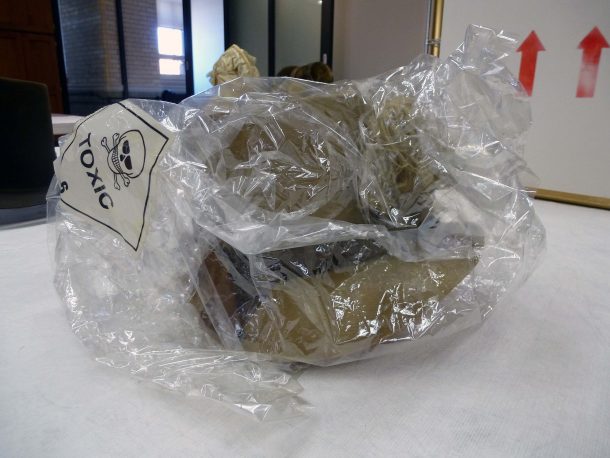Some visitors might find being presented with a hat kept inside a strong plastic bag, emblazoned with a skull-and-crossbones and the word ‘TOXIC‘ in big authoritative letters, a little alarming. Perhaps they would be led to think that we had turned buccaneer, or perhaps that Captain Kidd‘s most cherished secret, the one that he took to his piratical grave, was a fondness for little poke bonnets. Visitors (and readers of blogs) of the less nervous, more chemically-aware, more pre-adolescent literary nature may have guessed by now that the reason for these bags is not to strike terror into merchantmens’ hearts, and nor is it to promote the interests of long-deceased marauders. What it does is tell us immediately is that this particular hat is impregnated with mercury.

The hat in question is a green poke bonnet dating from around 1816. It has a flat crown like a man’s top hat, and is made from beaver fur and adorned with ostrich feathers. Mercuric nitrate was used from the 17th century to cure the felts used in the construction of hats in a process known as ‘carroting’. Animal skins were immersed in a dilute solution of the compound, causing the fur and the pelt to separate and mat together. It was then dried in an oven causing the edges of the skin to turn orange (hence the bunnyfood reference). The skin could then be cut off in thin slices, consolidated, rolled into felt, then dyed and formed on a block to make a hat. Everyone will have heard the expression ‘as mad as a hatter’, which is a somewhat unkind phrase that originated from observations of the symptoms shown by hatters and mill-workers who had suffered prolonged exposure to mercury vapours. Indicators of mercury poisoning include uncontrollable twitching, confused speech and memory loss, and in particularly nasty cases, dementia and bleeding from the ears and mouth. Not nice, and also not subject to legislature until the mid-20th century.
Clearly we would all prefer to avoid the “hatter’s shakes”, and so a number of our hats are kept safely sealed, which allows us to still show them to our visitors if they’re requested.



Yikes – do all fur hats from the first half of the 19th C therefore have this risk, or are these examples that you’ve tested and found to have harmful levels?
Hello, Jane. Not all hats are toxic but some do have high levels of toxins still in them. All of ours were tested some years ago and only a few were treated in this way. The possible presence of hazardous substances is something that owners of historic headwear should be aware of, though.
We need to test our hats for Mercuric nitrate are you able to tell me how you tested your collection?
Dear Sirs: I work at a small museum and we have at least two dozen beaver/rabbit top hats. About half are still in their original leather carrying cases , the rest in cardboard hat boxes. The earliest seems to be about late 1830’s and go through to the 1890’s. No one has ever thought about mercury
contamination until now. As curator, I would like to see that they are handled in the safest manner for the staff and visitors. Could you please tell me if you used testing kits and did the work yourselves or you had the hats sent to a lab. If you used a kit, what is the name of the product. I would appreciate any help you could give.
Hello Penny, thanks for getting in touch. The actual testing took place a little before my time, but if you email the V&A’s Conservation department at conweb@vam.ac.uk then they should be able to help you. Good luck!